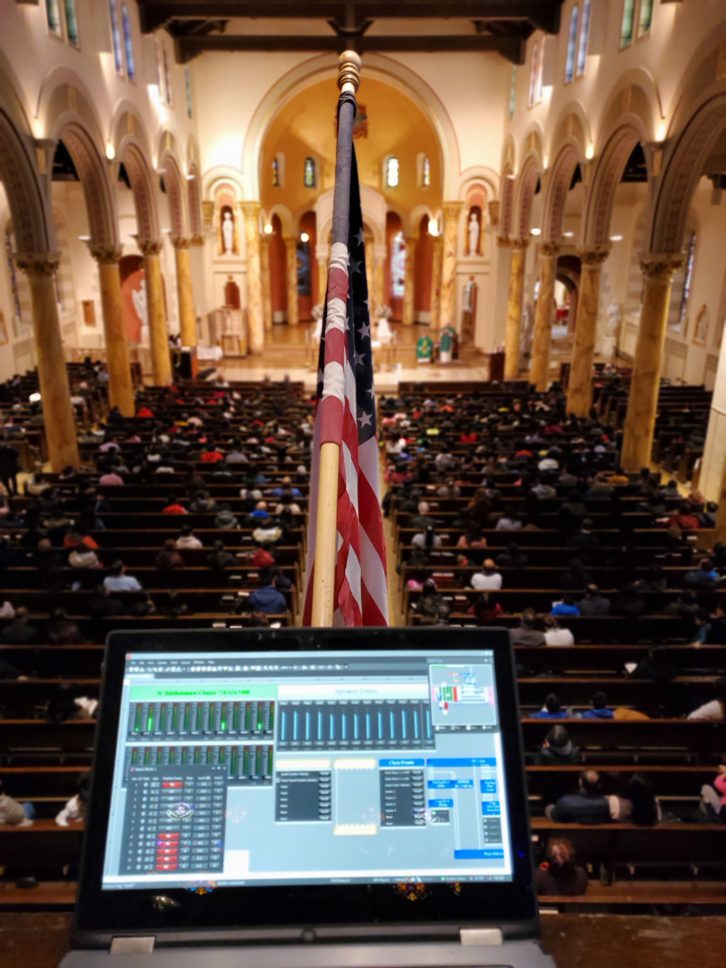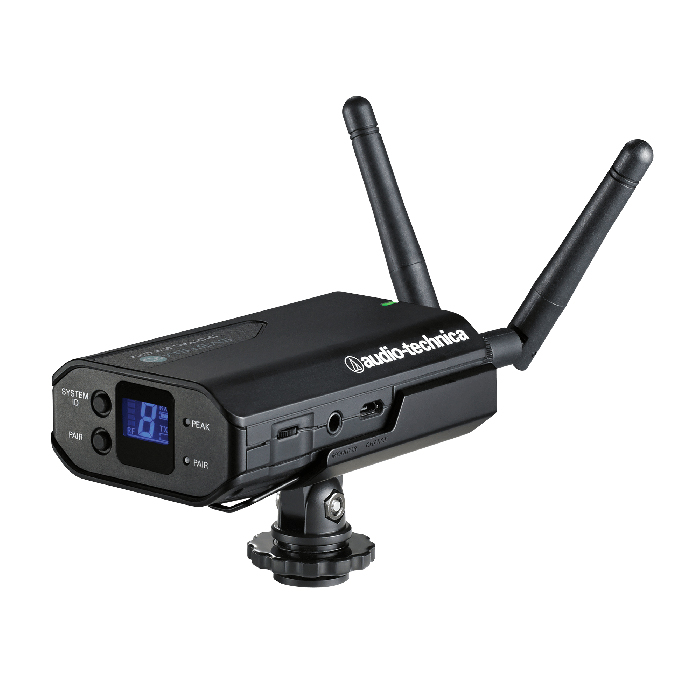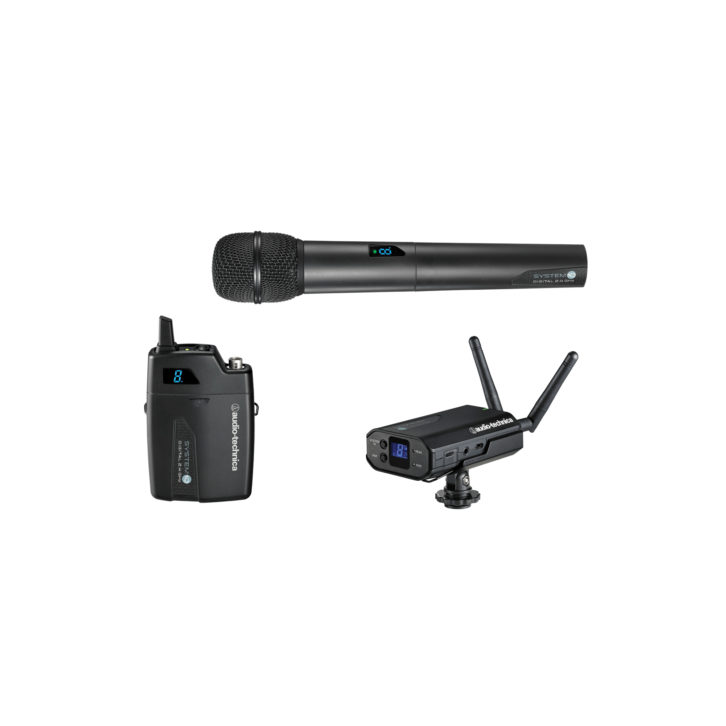
The pandemic has hit the AV industry hard and we’re writing the rulebook on how to deal with it as we go. At Monte Brothers in New York, they’re designing and installing sound systems in a trying time. Steve Minozzi talks about using remote system maintenance and solutions to AV supply line issues to give his clients—especially churches.
SVC: Steve, great to have you back with us on the SVC Podcast from Monte Brothers in New York. It was late last year when we talked about more routine things but with everything that’s going on now that may as well have been a hundred years ago.
Steve Minozzi: [Laughs] You got that right.
How’s Monte Brothers doing? How are you guys hanging in there?
We’re actually very busy trying to help everyone because COVID-19 has created problems that people didn’t envision. So we’re busy and we have to deal with whatever the restrictions are that are constantly in motion. There’s nothing solid or stable out here right now.
Yes, that seems to be the case everywhere. Are you experiencing different pandemic response rules in the various states? That must make AV operations more challenging since it’s not one size fits all.
No, it’s not. Initially restrictions in the Southern states were less severe than, obviously, here in New York. We’re in the center of the pandemic. Our headquarters are in Ardsley, which is roughly 15 minutes from New Rochelle where the whole thing started in New York. So we were under severe restrictions here. We were allowed to proceed because we were under New York State law; our attorneys reviewed everything and we were considered telecommunications. And because we worked for law enforcement at NYPD and various other law enforcement agencies in Westchester County, we were able to function. We went to our employees and explained if you’re uncomfortable you stay home and we paid them, those that wanted to stay home. The other advantage to Monte Brothers was we are a very computer-oriented company because our design and sound systems management and implementation of systems are all done with computers. So remote access for all of our employees was not very difficult, and actually a lot of it is still in place now, because we’re complying with New York State and their restrictions on how many people can be in a space at one time.
With installation and upgrade projects all over the country you have different rules everywhere you go. I think you had an experience with a South Carolina church.
In South Carolina, churches were not severely restricted like New York. In New York, New Jersey, and Connecticut the churches were shut down. You could not use them. In South Carolina, we were doing a very big installation in North Myrtle Beach, a huge church holding about 1,500 people. They were permitted to open with about 400-450 people in the space, though less than half of that many initially came. That was then. Now, New York is doing better and is restricting travel from about 22-24 other states in the country; so if we send people to those states they have to quarantine for two weeks when they come back to New York. We had to reschedule everything again. We have to work around whatever COVID-19 puts out the next day.
Can you describe your remote operation and maintenance capability and how that protects your workers and your clients?
Well, it goes back to 9/11. We got commissioned to do the new counterterror division for NYPD that was under the joint terrorism task force President Bush formed right after 9/11. New York had a secret 1,000-man headquarters in Brooklyn. They commissioned us to outfit it with sound so they could communicate internally. There was also a lot of different monitoring of international TV and other information all done in this 10,000 square foot secret facility. We brought in a bunch of experts from all over the country. We did the whole project, which was between $8-13 million and it was successfully implemented. The technicians that we became associated with during that time are still with us. So later on, as the DSP processors and internet grew in capability, we commissioned some of the guys to design a proprietary remote access system that would allow us to access and control the sound system from anywhere in the country to anywhere in the country. So for instance, the cathedral in Cincinnati, St. Peter in Chains Cathedral, is our account. One Sunday morning they had an emergency two weeks ago– they’re streaming and their system went down. Evidently there was a power surge. Our technician was on the New Jersey Turnpike. He pulled his vehicle over, accessed their system and got them back up and running. That was on a Sunday morning. So we already had that kind of technology, which meant COVID’s restrictions were not terribly restrictive for us as a company.
 Now when you install a sound system anywhere, you automatically include a separate broadcast audio output as a standard thing.
Now when you install a sound system anywhere, you automatically include a separate broadcast audio output as a standard thing.
That’s correct. That also happened after 9/11. For those funeral services, they had to have overflow outside. At that point, we realized that our sound systems should have broadcast-quality audio outputs that could be used for that purpose. So since 2001, our sound system designs automatically include multiple broadcast-quality outputs. That’s pure microphone without processing or equalization so it can be used for whatever you want. For example for a police funeral, you’ll have 20,000 police that are out in the street in addition to the people in the church. The police can come with their trucks and take the audio from the church and broadcast out to the massive amount of people outside. So that capability was already part of our system when COVID-19 hit and churches needed emergency streaming. A lot of churches were doing it with smart phones, tablets, whatever way they could. We were able to help them because our broadcast feed could be sent, via wireless in many cases, to their streaming device inside the church. They could put the phone or the camera right in front of the sanctuary and stream out over Internet through the device. It’s operating on 2.4 gig, it’s digital and it takes the broadcast audio and sends it right to the camera. They were able to do that with their cameras or their smart devices, phones or tablets, so they were streaming with pretty good audio. Kind of jury-rigged, but it worked.
I believe you used the Audio-Technica System Ten just straight to a phone. Is that something you use a lot?
It was very successful. We have close to 1,500 accounts in the country. I believe Audio-Technica is the biggest wireless manufacturer in the United States and I think we’re their biggest wireless customer. We’re not a big company, but we specialize heavily in wireless microphones.
And that brings up the issue of equipment availability now. What’s been your experience with supply line issues?
It’s been extremely difficult. This has to be the case with all the manufacturers. We have an extremely strong relationship with Audio-Technica. For over 35 years we’ve worked with them in the design of a specific microphone design–the Engineered series wireless systems that we helped develop prior to the evacuation of the 600MHz band. Unfortunately with all of the companies, Audio-Technica, PowerSoft, in Italy, the factories were either shut down or people didn’t come to work, so the supply line started to diminish. When they opened up, there was social distancing required, from what I’m told, so they had to restructure their assembly plants, shipping departments and everything. And I’m sure this is true for a lot of companies. They had to restructure a lot of their spaces, which took time. They may still be doing it now. But that, of course, put a damper on things. Everything was negatively affected by this.
And so AV integrators are having to try to plan ahead and get their orders in as early as they can.
Yeah. Fortunately again, because we specialize in houses of worship we don’t RFBs; we design/build with the consultant, the designer, and the installer. So we’re able to specify certain products. Audio-Technica works with us and we have reserved model products that have certain features as far as guarantee, service, repair. We know all of the equipment we need. We’re able to give them these orders ahead of time. We’re not waiting for the order to come in the door. We’re well setup with work that we have to complete, so that helps the manufacturer. All of them, Audio-Technica, PowerSoft, Biamp, we’re able to give them the orders in advance of needing them. That helped us a bit, but it’s still very tough. I’m sure every AV integrator is getting killed with this. I mean, even getting cameras and stuff on the Internet, you can’t get them.
I’ve heard from quite a few people who say the same thing, that they’ve had supply problems, having to plan ahead as far as they can and work on general infrastructure in the meantime.
Well, fortunately we know what we need and we can predict what we need because we know what we sold to these accounts. We track everything. We have accurate records of what they have, what frequencies are in their church, everything. Almost all of them are doing the necessary upgrades. Plus, believe it or not, the churches are using the time while closed to make improvements to their sound. The attitude is extremely positive in houses of worship. They know they’re going to open up again at some point and this is going to go away, so their point is hey, let’s be ready. We’re getting tremendous inquiries, we’re doing upgrade proposals, and we’re upgrading systems along with new ones.
And this isn’t happening in a vacuum. There were already big things going on in the AV industry. How do you think the supply problems are affecting the wireless microphone migration out of the 600MHz band?
 Severely. Just right now we are backed up. Audio-Technica extended their rebates. The government had a July 13 deadline before COVID, so everyone was getting frantic about that. Now I know Audio-Technica has just extended their wireless rebate to our customers to September 30. And to be honest with you, we’re lucky if we can get all this work done. You need the equipment and you need the manpower. Our technicians are back to work. They’re comfortable. They follow all the procedures, social distancing, and I will say, I’ve been to quite a few houses of worship and everyone is complying with New York’s restrictions. They’re wearing the masks, they’re social distancing. The churches are sectioning off where people can sit. So life goes on. People are still going to go to their church. They’re not going to stop going to church.
Severely. Just right now we are backed up. Audio-Technica extended their rebates. The government had a July 13 deadline before COVID, so everyone was getting frantic about that. Now I know Audio-Technica has just extended their wireless rebate to our customers to September 30. And to be honest with you, we’re lucky if we can get all this work done. You need the equipment and you need the manpower. Our technicians are back to work. They’re comfortable. They follow all the procedures, social distancing, and I will say, I’ve been to quite a few houses of worship and everyone is complying with New York’s restrictions. They’re wearing the masks, they’re social distancing. The churches are sectioning off where people can sit. So life goes on. People are still going to go to their church. They’re not going to stop going to church.
It may appear that congregations are coming back maybe not in full force like before but they still want to come in.
They do. And sooner or later everybody’s going to be back. It’s not a question of will people come back. One of the interesting things, though, is the churches now are moving toward the live streaming. I think they were not in favor of that much before because they felt better if the people were in the space, which is true. And you are required in certain religions to be physically present unless you have a reason. However, churches are realizing that during this time they’re still getting contributions to the church from the congregation. People are supporting their church. That money is going to benefit your worship capabilities, etc. So that’s not going to go away










